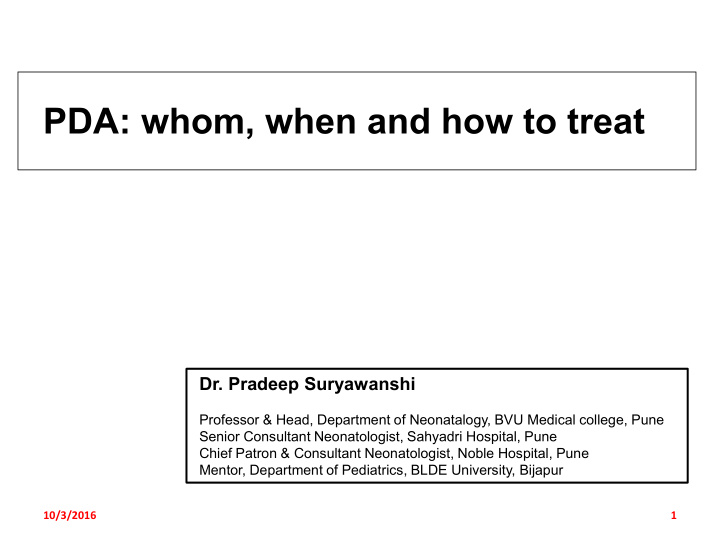



PDA: whom, when and how to treat Dr. Pradeep Suryawanshi Professor & Head, Department of Neonatalogy, BVU Medical college, Pune Senior Consultant Neonatologist, Sahyadri Hospital, Pune Chief Patron & Consultant Neonatologist, Noble Hospital, Pune Mentor, Department of Pediatrics, BLDE University, Bijapur 10/3/2016 1
Learning Objectives • Why – Why treat a PDA? • What – Can we identify a PDA that should be treated? • When – Can we identify the best time to treat? • With what – Do we have a treatment that has an acceptable risk/benefit ratio? 10/3/2016 2
Effects of PDA 10/3/2016 3
PDA Morbidity 10/3/2016 4
PDA Management Potential benefits of treatment • Avoid hypote�sio� • ‘edu�ed severe IVH �Prophyla�ti�� • ‘edu�ed pul�o�ary hae�orrhage • ‘edu�ed gut �o�pli�atio�s • ‘edu�ed surgi�al ligatio� • Possi�ly redu�ed CLD if �losed earlier 10/3/2016 5
10/3/2016 6
PDA Evaluation • In first 72 hrs PDA can ONLY be diagnosed with echocardiography as typical signs & symptoms of PDA shunting are absent • Haemodynamic significance precedes development of clinical signs by an average of 2 days (range 1 – 4 days) 10/3/2016 7
10/3/2016 8
ECHO: What is a “significant” PDA? 10/3/2016 9
Is the ductus patent ? Imaging the duct – 2 D A �three - legged stool� appeara��e - Right pulmonary artery (RPA) and left pulmonary artery (LPA) forming the right and middle legs, and the duct forming the third leg 10/3/2016 10
Is the ductus patent ? Imaging the duct – Colour Colour Doppler ultrasound - Bright flare of colour - Detection of a patent duct easy 10/3/2016 11
Color Doppler duct diameter Small duct Big duct 10/3/2016 12
Size of Duct Message 4- Duct Diameter < 1.5 mm – Usually insignificant Duct Diameter 1.5 – 2 mm – Significant variable / Use with DA flow Duct Diameter > 2.0 mm – Usually Significant 10/3/2016 13
Range of ductal constriction at 5 hours < 30 weeks, N= 124 Poor early constriction Tend to stay patent Good early constriction Tend to close
Direction and Pattern of ductal shunt Analysis of the direction of ductal shunting requires PD/CW Sampling gate placed at pulmonary end of duct 10/3/2016 15
Pure Left to Right shunt 10/3/2016 16
Bidirectional shunt Pulmonary pressures are still below systemic pressures There is a period in early systole when pulmonary pressures > systemic pressures, there is an early period of a R to L shunt, followed by L to R shunt 10/3/2016 17
10/3/2016 18
Evaluation of chamber dilatation : LA: AO 19
LA: AO - > 1.4 Ao Ao LA LA 10/3/2016 20
LVEDD/Ao >2.1 10/3/2016 21
10/3/2016 22
10/3/2016 23
PDA: (“Ductal steal”) Diastolic aortic pressure is low with a large left to right ductal shunt - ductal steal Steal - Blood passing down the descending aorta during systole goes backwards up the arterial duct and into the pulmonary arteries during diastole Relative under perfusion of ALL systemic arteries Co��o�ly �i�terrogated� arteries: Descending aorta/Mesenteric/Renal/Anterior Cerebral 10/3/2016 24
Descending aorta flow 10/3/2016 25
Descending aorta flow 10/3/2016 26
Abnormal flow pattern – Absent ACA 10/3/2016 27
Abnormal flow pattern – REDF SMA 10/3/2016 28
Abnormal flow pattern – REDF Renal Artery 10/3/2016 29
10/3/2016 30
Take Home message Sehgal & McNamara Eur J Pediatrics. 2009 10/3/2016 31
10/3/2016 32
Shahab Noori 2014 10/3/2016 33
Argument to treat early • Effects of shunt – Short term – Hypotension, PH, IVH, Ductal steal – Medium term – CLD, PVL • Effects of treatment – Acute – no increase shown in prophylaxis trials (NEC, SIP) – Long term – no difference in ND outcome (TIPP trial) • Benefits to earlier treatment – Better timing – More efficacious – In right time frame for other benefits – reduced IVH, PH, hypotension 34
Sellmer et al. ADC F&N 2013 10/3/2016 35
10/3/2016 36
With what ? Treatment of PDA • Conservative – positive pressure – fluid restri�tio�/�he�i�al �a�di�g�↑pCO2, ↓pO2� – Diuretics – increase hematocrit • Medical – Indomethacin – Ibuprofen – Intravenous/Oral – Paracetamol • Surgical ligation 10/3/2016 37
Ibuprofen is as effective as indomethacin in closing a PDA and currently appears to be the drug of choice. Ibuprofen reduces the risk of NEC and transient renal insufficiency. Oro-gastric administration of ibuprofen appears as effective as iv administration. 10/3/2016 38
Key Messages • PDA is not benign and increases risk of death and complications of prematurity • Clinical and echocardiography criteria differ for early targeted and late symptomatic treatment • Late treatment of a symptomatic PDA does not improve clinical & long term outcomes • If PDA unlikely to close spontaneously then treatment before it becomes symptomatic may be beneficial – trials are needed to assess this approach
Recommend
More recommend